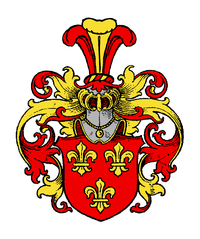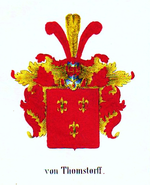Thomstorff
Thomstorff , historically also Tomsdorf , Thomsdorf , Thomstorp , Dompsdorff or even Dahmsdorff , is the name of an old, Brandenburg and Mecklenburg noble family that was later able to spread to Holstein and Denmark . The family flourished at least until the middle of the 19th century.
history
The Thomstorff were first mentioned in the Uckermark with Henning von Thomsdorf in 1304. From 1503 Mechtild Thomsdorf was abbess of the Boitzenburg monastery or at the Thomsdorf headquarters . The family must have moved to Mecklenburg by 1500 at the latest. Because as early as 1523 Achim , Achim and Claus Thomstorff belonged to the family among the co-seals of the Mecklenburg Union . Franz von Dompsdorf († 1582) was the last Commander of the German Order in Bremen .
Carl Dietrich von Thomstorff (1688–1748), since 1724 on the family estate in Rothspalk, was lieutenant colonel and president of the regional court in Güstrow and from 1746 to 1748 provisional in the Dobbertin monastery . In the years 1724–1801, eight daughters of the von Thomstorff families were registered in the local register of the noble women's monastery.
His eldest son, Ernst Christian Friedrich von Thomstorff (1732–1792), was the author of the Rostock inaugural dissertation Agnetis augustae, Henrici III in 1754 . imperatoris coniugis, historia . He later held the office of President of the Court of Güstrow. Friedrich Christopher von Thomstorff was Mecklenburg Deputy Director of the Justice Office there around 1819 .
Around 1800 several of the family's sons were still officers in the Prussian army . August Ludwig von Thomstorff (* 1814) had been in the Austro-Hungarian Hussar Regiment No. 9 since 1837 and took the Hungarian side in the course of the Hungarian Revolution of 1848/1849 . In the battle of Mezőkövesd on February 28, 1849, the hussar officer Thomstorff had saved the life of his long-time friend, Prince Wilhelm of Schleswig-Holstein, who was fighting and wounded on the Austrian side, by protecting him from the hussars while wounded himself. August von Thomstorff succeeded Peter Giron , who was deposed on May 23, 1849, as commander of the German Legion of Hungarians, which was finally dissolved at the end of June . As such, he was captured by Austria and sentenced to death by shooting. General Haynau pardoned him to ten years imprisonment.
Historical property
- In Brandenburg
Headquarters : Thomsdorf (1407), still Jetzkendorf (1487–1564), both in the Templin district and Döberitz (1649) in the Osthavelland district .
- In Mecklenburg
Headquarters : Bergfeld (1506–1798) in the Strelitz office; furthermore Watzkendorf in the Feldberg office (at least 1720 and still 1759 - hence the name "von Thomstorff-Watzkendorff"), Carlsdorf (1801-1815), Gottin (1813-1825), Klaber (pledged 1792), Neuhof (1812-1815) and Rothspalk (1693–1811) in the Güstrow office; Dersentin (1804-1811) in the Goldberg office, Karchow (1600-1724) in the Stavenhagen office and Sophienhof (1802-1811) in the Lübz office.
coat of arms
The family coat of arms shows three golden lilies in the red shield . On the helmet with red and gold covers, three ostrich feathers (red, gold and red).
According to Friedrich Crull , old family seals (from the early days of the coat of arms ) have not been preserved; however, the ostrich feathers used to decorate the crest are certainly younger than the shield image. In the depiction of the coat of arms in the St. Klaren Monastery in Ribnitz, the helmet is crowned and the crest is a bush of red and golden feathers, which are also interpreted as cock feathers. Otto Titan von Hefner wrote in Johann Siebmacher's Great and General Wappenbuch in 1858 only about a "bush [...] feathers", as the drawing attached there on plate 19, based on historical models, shows a plume of feathers, although it is indifferent whether which consists of ostrich or rooster feathers.
Individual evidence
- ↑ Hans Henrich Klüver, description of the Hertduchy of Mechlenburg and associated countries and Oerter , Hamburg 1737, Volume 1, p. 175 ( digitized version ); also: University of Rostock / summer semester 1593, No. 7: Matriculation of Ioachimus a Thomstorp ( digital copy )
- ^ Heinrich Kaak , The Brandenburg local history in people, families and rural scenes , Brandenburgische Historische Kommission e. V., Potsdam 2011, p. 11 ( digitized version ( memento of the original from June 10, 2015 in the Internet Archive ) Info: The archive link has been inserted automatically and has not yet been checked. Please check the original and archive link according to the instructions and then remove this notice. ; PDF; 586 kB)
- ^ David Franck: Old and New Mecklenburg , Güstrow / Leipzig 1753, p. 77.
- ^ Dataset on Thomstorff, Ernst Christian Friedrich von in the catalog of the German National Library
- ^ The story of the Empress Agnes Augusta : digitized version
- ↑ For the winter semester 1781/82 Friedrich Christoph Viktor von Thomstorff was matriculated at the University of Rostock under No. 8.
- ↑ Grosherzoglich-Mecklenburg-Schwerin shearing State calendar Schwerin 1819 ( digitized )
- ↑ Anatole Wacquant, The Hungarian Danube Army 1848-49 , Breslau 1900, p. 135 ( digitized version )
- ↑ Peter Broucek , Military Resistance: Studies on Austrian State Conflict , 2008, p. 197
- ↑ Ernst Heinrich Kneschke, New General German Adels Lexicon (Steinhaus - Zwierlein), p. 479 ( digitized version )
- ^ Gustav von Lehsten: The nobility of Mecklenburg since the land constitutional hereditary comparisons (1755). Rostock 1864, p. 268 ; see. also the lithography around 1840 (JG Tiedemann, Mecklenburgisches Wappenbuch , Rostock 1837-39, plate 186)
- ↑ Friedrich Crull : The coats of arms of the genders of the team that occurred up to 1360 in today's borders of Meklenburg. In: Association for Mecklenburg History and Archeology : Yearbooks of the Association for Mecklenburg History and Archeology . Vol. 52 (1887), p. 137, no.393
- ↑ Rainer Münzing: The Landadel in Mecklenburg , A consideration of the Mecklenburg Landadel and its coat of arms, found in the St. Klaren Monastery in Ribnitz, Wismar 1998.
- ↑ a b Otto Titan von Hefner , Johann Siebmacher's Great and General Wappenbuch Volume 3, Department 6, (Mecklenburgischer Adel), Nuremberg 1858, p. 20 ( text ), ( illustration )
literature
- Friedrich Crull : The coats of arms of the genders of the team that existed in today's Meklenburg boundaries until 1360. In: Association for Mecklenburg History and Archeology : Yearbooks of the Association for Mecklenburg History and Archeology . Vol. 52 (1887), p. 137, no.393
- Otto Titan von Hefner : Register of the blooming and dead nobility in Germany , Volume 4, Regensburg 1866, S: 77 , Col. 1, Thomstorff and P. 85, Col. 2, Tomesdorf
- Johann Christian von Hellbach : Adels-Lexikon. Volume 2, Ilmenau 1826, p. 583
- Ernst Heinrich Kneschke : New general German nobility lexicon . Volume 9, Leipzig 1870, p. 196
- Leopold von Ledebur : Nobility Lexicon of the Prussian Monarchy . Volume 3, Berlin 1858, p. 15
- Gustav von Lehsten: The nobility of Mecklenburg since the constitutional hereditary comparisons (1755). Rostock 1864, p. 268
- Leopold von Zedlitz-Neukirch : New Prussian Adelslexicon Volume 5, Leipzig 1837, p. 267


